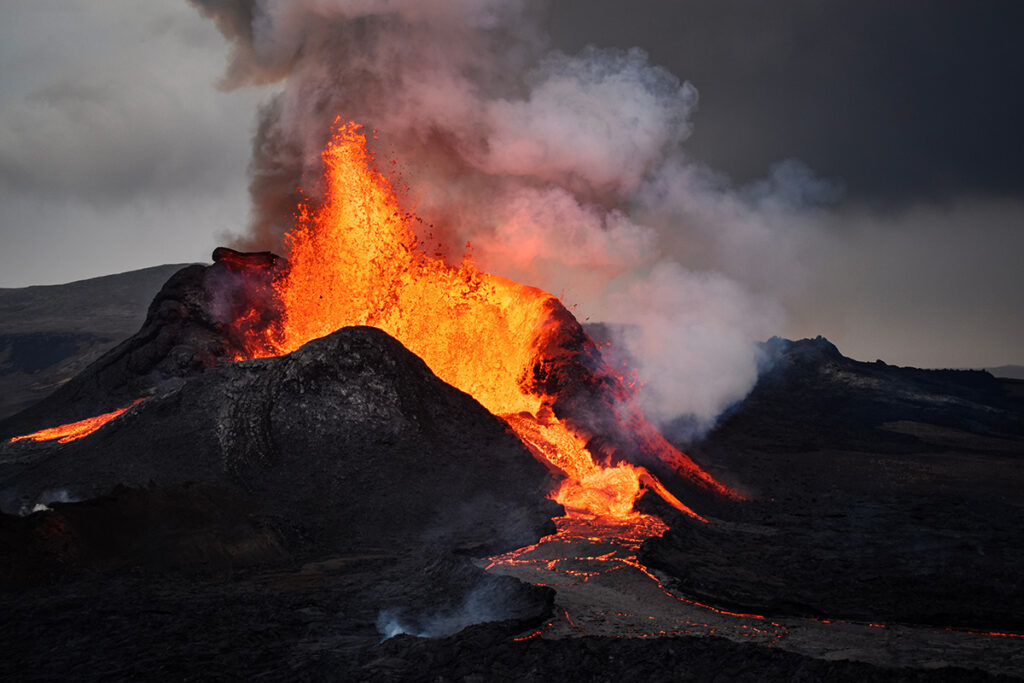Lava and Earthquakes Rock the Reykjanes Peninsula
A powerful volcanic eruption in southwest Iceland has triggered widespread evacuations of both residents and tourists, as lava and smoke continue to pour from the Sundhnúk crater range. The eruption began suddenly in the morning hours, following a series of earthquakes in the region. A massive fissure has since opened, stretching approximately 1.2 kilometers across the rugged terrain, creating a fiery landscape filled with molten lava and toxic gases.
The Reykjanes Peninsula, where this eruption is taking place, has experienced several similar events in recent years. For centuries, the area remained dormant, but it has now entered a new volcanic phase. The latest activity confirms that magma is moving more extensively than before, with a newly formed underground corridor reaching up to 11 kilometers—further northeast than previously recorded eruptions in the region.
This geological shift has resulted in continuous tremors and physical damage to the surrounding land. The intensity of the activity and the scale of the magma spread have sparked concerns about the long-term stability of the area.
Town of Grindavík Under Threat
The eruption poses a direct threat to the nearby fishing town of Grindavík, located close to the volcanic site. The town, already under constant monitoring due to previous eruptions, now finds itself in a critical situation. Protective barriers built around Grindavík have been breached by new eruptive fissures, some of which opened just a few hundred meters inside the perimeter.
Significant damage has already been confirmed within the town. A hot water pipeline broke in the northern area, suggesting deep underground cracking and further destabilization. Although most of Grindavík’s 4,000 residents had evacuated the area during previous volcanic episodes, a small number of individuals have chosen to stay behind in their homes, despite clear warnings to evacuate the danger zone.
Authorities have enforced road closures in and out of the town to ensure safety. While air travel remains unaffected for now, the overall accessibility to Grindavík has been heavily restricted.
Impact on Tourism and the Environment
One of Iceland’s most visited tourist attractions, the Blue Lagoon spa, is located in close proximity to the eruption site. This iconic geothermal destination, known for its warm mineral-rich waters, has also been affected by the ongoing natural disaster. Tourists in the surrounding area have been swiftly evacuated as a precautionary measure, as lava flows and toxic emissions continue to threaten infrastructure and safety.
Gas pollution from the eruption is currently being carried northeast by prevailing winds, placing Iceland’s capital and nearby regions under environmental alert. While the concentration of pollutants remains under observation, the combination of lava flows, smoke, and seismic activity presents serious risks to air quality and local ecosystems.
In a striking image of the eruption’s proximity to civilization, flames and glowing lava have been seen from a greenhouse on the outskirts of Grindavík. The sight underscores just how close this powerful force of nature is to human settlements.
A Volcanic Era Reawakened
The Reykjanes Peninsula is no stranger to volcanic activity, but the renewed eruptions mark a significant return after centuries of dormancy. Since the first eruption in this new active cycle, the region has been under continuous geological stress. The increasing frequency of eruptions, fissures, and magma expansion suggests that Iceland may be entering a prolonged period of volcanic instability.
Iceland sits on the Mid-Atlantic Ridge, a dynamic boundary between two massive tectonic plates. With 33 active volcanic systems, the country is constantly at risk of geological events. However, the recent developments near Grindavík represent a more aggressive and unpredictable pattern of activity, raising concerns for long-term safety and planning.
Local authorities continue to monitor the situation closely, focusing on public safety and structural containment. While volcanic activity slightly eased in the early afternoon, the threat remains. Ongoing assessments will determine the next steps for managing the eruption and its consequences for nearby communities.



